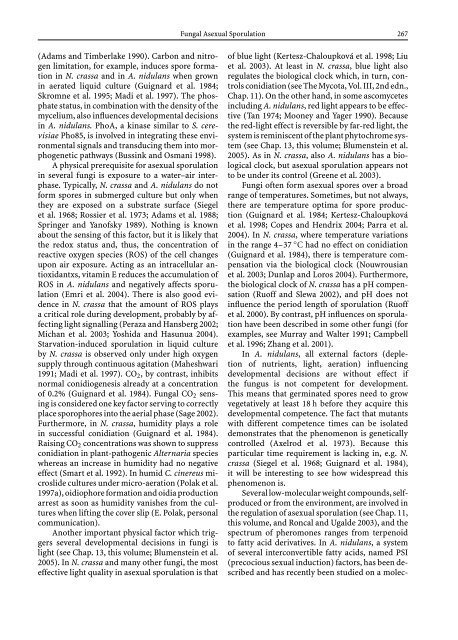Growth, Differentiation and Sexuality
Growth, Differentiation and Sexuality
Growth, Differentiation and Sexuality
Create successful ePaper yourself
Turn your PDF publications into a flip-book with our unique Google optimized e-Paper software.
(Adams <strong>and</strong> Timberlake 1990). Carbon <strong>and</strong> nitrogen<br />
limitation, for example, induces spore formation<br />
in N. crassa <strong>and</strong> in A. nidulans when grown<br />
in aerated liquid culture (Guignard et al. 1984;<br />
Skromne et al. 1995; Madi et al. 1997). The phosphate<br />
status, in combination with the density of the<br />
mycelium, also influences developmental decisions<br />
in A. nidulans. PhoA, a kinase similar to S. cerevisiae<br />
Pho85, is involved in integrating these environmental<br />
signals <strong>and</strong> transducing them into morphogenetic<br />
pathways (Bussink <strong>and</strong> Osmani 1998).<br />
A physical prerequisite for asexual sporulation<br />
in several fungi is exposure to a water–air interphase.<br />
Typically, N. crassa <strong>and</strong> A. nidulans do not<br />
form spores in submerged culture but only when<br />
they are exposed on a substrate surface (Siegel<br />
et al. 1968; Rossier et al. 1973; Adams et al. 1988;<br />
Springer <strong>and</strong> Yanofsky 1989). Nothing is known<br />
about the sensing of this factor, but it is likely that<br />
the redox status <strong>and</strong>, thus, the concentration of<br />
reactive oxygen species (ROS) of the cell changes<br />
upon air exposure. Acting as an intracellular antioxidantxs,<br />
vitamin E reduces the accumulation of<br />
ROS in A. nidulans <strong>and</strong> negatively affects sporulation<br />
(Emri et al. 2004). There is also good evidence<br />
in N. crassa that the amount of ROS plays<br />
acriticalroleduringdevelopment,probablybyaffecting<br />
light signalling (Peraza <strong>and</strong> Hansberg 2002;<br />
Michan et al. 2003; Yoshida <strong>and</strong> Hasunua 2004).<br />
Starvation-induced sporulation in liquid culture<br />
by N. crassa is observed only under high oxygen<br />
supply through continuous agitation (Maheshwari<br />
1991; Madi et al. 1997). CO2, by contrast, inhibits<br />
normal conidiogenesis already at a concentration<br />
of 0.2% (Guignard et al. 1984). Fungal CO2 sensing<br />
is considered one key factor serving to correctly<br />
place sporophores into the aerial phase (Sage 2002).<br />
Furthermore, in N. crassa, humidity plays a role<br />
in successful conidiation (Guignard et al. 1984).<br />
Raising CO2 concentrations was shown to suppress<br />
conidiation in plant-pathogenic Alternaria species<br />
whereasanincreaseinhumidityhadnonegative<br />
effect (Smart et al. 1992). In humid C. cinereus microslide<br />
cultures under micro-aeration (Polak et al.<br />
1997a), oidiophore formation <strong>and</strong> oidia production<br />
arrest as soon as humidity vanishes from the cultures<br />
when lifting the cover slip (E. Polak, personal<br />
communication).<br />
Another important physical factor which triggers<br />
several developmental decisions in fungi is<br />
light (see Chap. 13, this volume; Blumenstein et al.<br />
2005). In N. crassa <strong>and</strong> many other fungi, the most<br />
effective light quality in asexual sporulation is that<br />
Fungal Asexual Sporulation 267<br />
of blue light (Kertesz-Chaloupková et al. 1998; Liu<br />
et al. 2003). At least in N. crassa, bluelightalso<br />
regulates the biological clock which, in turn, controls<br />
conidiation (see The Mycota, Vol. III, 2nd edn.,<br />
Chap. 11). On the other h<strong>and</strong>, in some ascomycetes<br />
including A. nidulans, red light appears to be effective<br />
(Tan 1974; Mooney <strong>and</strong> Yager 1990). Because<br />
the red-light effect is reversible by far-red light, the<br />
system is reminiscent of the plant phytochrome system<br />
(see Chap. 13, this volume; Blumenstein et al.<br />
2005). As in N. crassa, alsoA. nidulans has a biological<br />
clock, but asexual sporulation appears not<br />
to be under its control (Greene et al. 2003).<br />
Fungi often form asexual spores over a broad<br />
range of temperatures. Sometimes, but not always,<br />
there are temperature optima for spore production<br />
(Guignard et al. 1984; Kertesz-Chaloupková<br />
et al. 1998; Copes <strong>and</strong> Hendrix 2004; Parra et al.<br />
2004). In N. crassa, where temperature variations<br />
in the range 4–37 ◦ C had no effect on conidiation<br />
(Guignard et al. 1984), there is temperature compensation<br />
via the biological clock (Nouwrousian<br />
et al. 2003; Dunlap <strong>and</strong> Loros 2004). Furthermore,<br />
the biological clock of N. crassa has a pH compensation<br />
(Ruoff <strong>and</strong> Slewa 2002), <strong>and</strong> pH does not<br />
influence the period length of sporulation (Ruoff<br />
et al. 2000). By contrast, pH influences on sporulation<br />
have been described in some other fungi (for<br />
examples, see Murray <strong>and</strong> Walter 1991; Campbell<br />
et al. 1996; Zhang et al. 2001).<br />
In A. nidulans, all external factors (depletion<br />
of nutrients, light, aeration) influencing<br />
developmental decisions are without effect if<br />
the fungus is not competent for development.<br />
This means that germinated spores need to grow<br />
vegetatively at least 18 h before they acquire this<br />
developmental competence. The fact that mutants<br />
with different competence times can be isolated<br />
demonstrates that the phenomenon is genetically<br />
controlled (Axelrod et al. 1973). Because this<br />
particular time requirement is lacking in, e.g. N.<br />
crassa (Siegel et al. 1968; Guignard et al. 1984),<br />
it will be interesting to see how widespread this<br />
phenomenon is.<br />
Several low-molecular weight compounds, selfproduced<br />
or from the environment, are involved in<br />
the regulation of asexual sporulation (see Chap. 11,<br />
this volume, <strong>and</strong> Roncal <strong>and</strong> Ugalde 2003), <strong>and</strong> the<br />
spectrum of pheromones ranges from terpenoid<br />
to fatty acid derivatives. In A. nidulans, asystem<br />
of several interconvertible fatty acids, named PSI<br />
(precocious sexual induction) factors, has been described<br />
<strong>and</strong> has recently been studied on a molec-

















